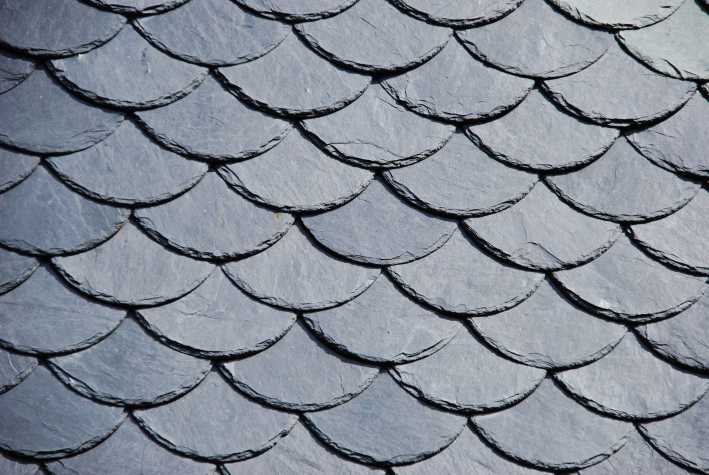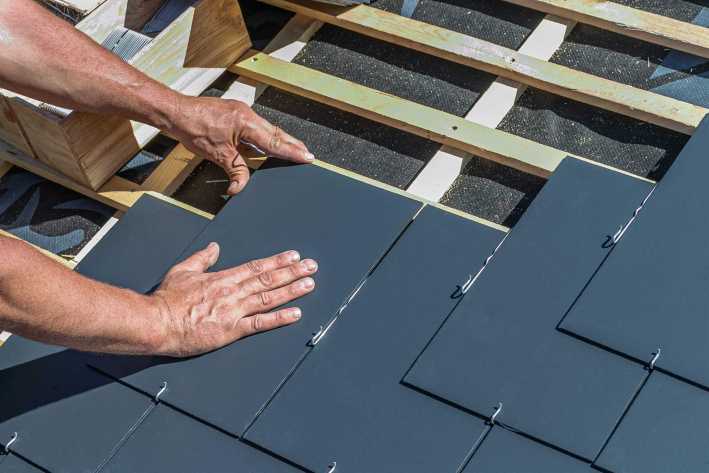
Does tile roofing a suitable coverage material for your h...
Are you in the market for a roofing material that combines uncompromised durability and aesthetic...
When homeowners face the issue of replacing the roof, they most often seek to upgrade to more durable and weatherproofing roofing material than their existing coverage. And their choice commonly falls on slate tiles made of natural stone. This roofing has a long history and was initially seen as a ready-made building material with perfect fire and pest resistance. These days, slate possesses the same qualities but has even better visual appeal and extended service life that can be as long as 200 years. No other roofing options can be compared to slate in endurance. However, you should be ready to spend wads of money to cover your roof with slate shingles.

We want you to make an informed decision about installing this costly roofing material. This article will help you consider its strong and weak points, upkeep requirements, and related costs. Keep reading to learn what a slate roof is and whether it makes sense to pick one for your house. We bet you will come to the right conclusion once analyzing all the given information.
Table of contents
2. Slate roofing - Advantages and downsides
3. The top slate roof styles to consider
4. Slate roofing vs. asphalt shingles - What is the difference?
5. The national average slate roofing costs
6. Why hire a narrow-focused slate roofing contractor?
Slate tiles rank amongst the premium roofing materials of extra quality and durability. Their shining look and sturdiness are explained by their origin. Slate is made from a natural stone with a high mica content. It is mined, cut into flat pieces, and processed to use as a roofing material. In contrast to other roof coverages, slate tiles are installed one at a time.
This roofing coverage is considered a solid investment that brings a great return over time. Depending on the selected type of tiles, you can expect them to serve for centuries. Thus, hard roofing slates like purple or grayish-black ones can last 150 to 200 years. They're incredibly durable and have ultimate moisture and fire resistance. Soft sorts of slate roofing have a shorter service life, lasting from 75 to 100 years. That is why their price is considerably lower.
One of the drawbacks of a slate roof is its weight. The structure of your home should be solid enough to hold heavy slate tiles that can weigh up to 250 pounds per square. Consider consulting a knowledgeable engineer about the structural integrity of your house and the need for extra reinforcement before installation.
Want to ensure your roof will last its maximum service life? Pick a long-lasting material for roof decking to ensure it will have the same lifespan as most types of slate shingles. Any board glued together for the decking will take you a lower upfront cost but result in unnecessary repairs in the long run. Instead, opt for solid wood boards or durable synthetic materials for the sheathing. The nails should also be selected from the point of their longevity and rust resistance. Consider copper or stainless steel nails as they last longer than other metals.
When selecting slate roofing tiles, it's crucial to determine where they come from. The well-known American mines are located in Kentucky, Vermont, and New Hampshire. Major foreign suppliers of slate are Italy, China, and Brazil. When you have an idea of the rock's origin, you can predict the service life of your roofing and the length of its warranty.
A roof made of slate must be installed with an adequate headlap. Otherwise, there is a risk of large gaps and premature deterioration. Consider using a four-inch headlap for lower roof slopes and a three-inch one for steep-sloped constructions. If your new slate roof has been installed with a headlap less than 2 inches, the chances it will fall one day.

Slate tiles have multiple upsides that are explained by their organic origin. Natural slate is lauded for its unique eye-pleasing appearance and the super extended service life. However, slate tile roofs' costs are exorbitant. That is why you should consider both the advantages and downsides of this roofing material to ensure you get the right product for your home.
Slate is one of the most attractive roofing materials available on the market. It looks fantastic on classic-style homes and fits in with multiple exteriors. Slate tiles come in many types and textures, allowing to experiment and develop spectacular roofscapes.
Here are the primary styles of slate roofs you might be interested in:

Two popular roofing materials worth comparing are slate and asphalt. They both have an attractive design and serve to protect a house from the elements. However, these are probably the only common features they have. Read on to understand what roofing option is better for your home.
The cost of slate roofing depends on the area and the type of tiles. The average price you should expect to spend per square foot of top-shelf hard slate ranges from $1.300 to $3.000. Soft slate has a relatively shorter service life and costs $900 to $2.000 per square. Please note that the final quote can be affected by the roof's slope, pitch, and size.
Installing slate roofing also requires essential investment as the tiles are heavy and tricky to work with. Only a few companies are specialized in installing this roofing material. You will need to pay from $100 to $150 per square or $100 per hour. Besides, if your roof cannot bear the weight of tiles, you will need to add rafters and joists to reinforce its structure. Get ready to pay about $1.500 for this service.
We also have to mention the difference between synthetic slate shingles and natural ones, as you can easily get trapped by their cost gap. Synthetic is a more affordable roofing material with a shorter lifespan and worse resistance to the elements. This option typically costs from $500 to $1.000 per square. So, be accurate when somebody offers you a synthetic slate for the cost of a natural one. Always do your research before dashing down to a local roofing store.

If you're ready to invest about $30.000 for installing a slate roof on your home, hire a real pro who has a bunch of expertise working with this type of roofing material. Don't try to skimp on labor, as this is the key determiner of your roof longevity. As long as slate tiles are correctly mounted, they will be in mint condition for dozens of years.
No matter if you need a slate roof installation or replacement, hiring a proven roofing contractor is the recipe for your peace of mind. Whether you're on the hunt for a top individual roofer or a company in your county, let us help you expedite this process. Answer a few questions about your roofing project by this link, and we will get back to you with reasonable price quotations from experts operating nearby.
GET THE ESSENCE OF RELEVANT HOME
IMPROVEMENT TOPICS IN LESS THAN 5 MINUTES

Are you in the market for a roofing material that combines uncompromised durability and aesthetic...

Are you thinking about getting a new metal roof that is relatively inexpensive and simple to inst...

Stay tuned!